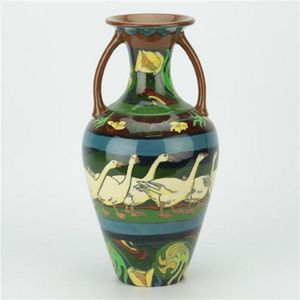Hand-painted Warwick Castle Royal Doulton Vase
You must be a subscriber, and be logged in to view price and dealer details.
Subscribe Now to view actual auction price for this item
When you subscribe, you have the option of setting the currency in which to display prices to $Au, $US, $NZ or Stg.
- Bone China - Bone china, Also called 'English china", is one of the three types of porcelain, the other two being soft paste porcelain and hard paste porcelain.
Porcelain is an ancient ceramic material, first made in China, hence the common name "china", and the introduction of bone china was to counter the imports of Chinese porcelain.
The initial development of bone china is credited to Josiah Spode, who introduced it around 1800 and it was soon after copied by other manufacturers including Minton, Coalport, Davenport, Derby, Worcester, Wedgwood and Rockingham and the Herculaneum factory at Liverpool.
Spode's bone china was made by mixing ash from cattle bones with feldspar and kaolin, which created a material that was stronger, more translucent, and whiter than traditional porcelain. He began to produce this new type of porcelain in 1796 and it quickly became very popular.
At the time, the process and ingredients were kept secret and were only known to a few manufacturers and were protected by patents.
In the 19th century, bone china became increasingly popular and was widely produced by many manufacturers in England. During this time, it was considered a luxury item and was often used to create fine dining sets and other decorative items.
Bone china is still used in the production of fine porcelain wares, such as tea sets, figurines, and other decorative pieces. His basic formula of six parts bone ash, four parts china stone, and three and a half parts china clay remains the standard English body. It is still considered a luxury item due to its strength, translucency, and whiteness, and is often used for high-end and high-quality porcelain. China.
This item has been included into following indexes:
- Hugh, John (England) - Royal Doulton, designers 11
- Plant, J. H. (John Hugh) - Royal Doulton, designers 27
-
Royal Doulton (England), item types
- ovoid and baluster shaped vases 1,515
- vases, other 743
Visually similar items

19th century Chinese porcelain vase. Of double gourd shape, clobbered with later added enamels. Red mark to base. Height 20 cm

Japanese cloisonne vase on a green ground, decorated to the neck with chrysanthemums, to the body with chrysanthemum & butterflies & having two beast head handles. Condition: good to fair, some enamel losses & wear consistent with age. Height 30.5 cm

A very large Sevres pattern porcelain blue ground vase, French, circa 1900 80 cm high

Wileman & Shelley 'The Foley Intarsio' vase by Frederick Rhead with two handles & decorated with a banding of geese. RdNo.330400. Condition good, some crazing, age related wear to the base. Height 23 cm
